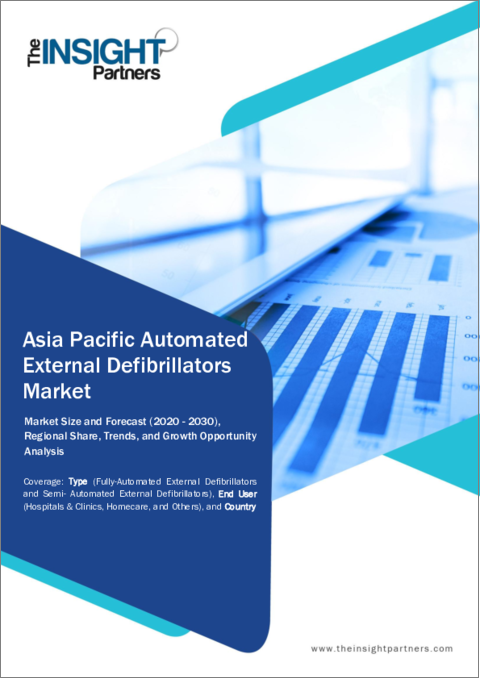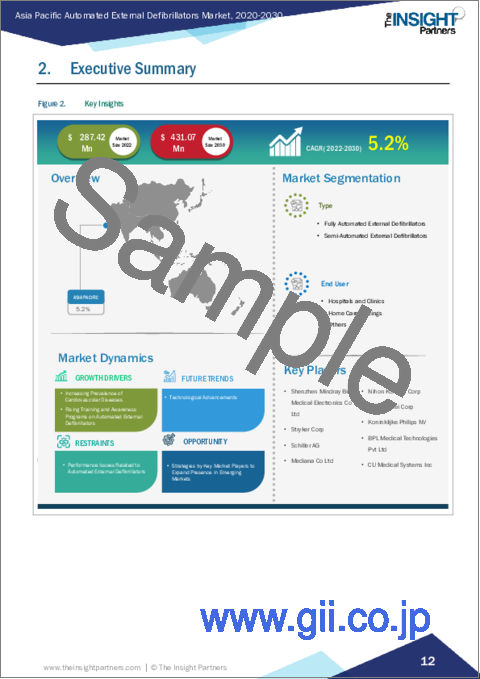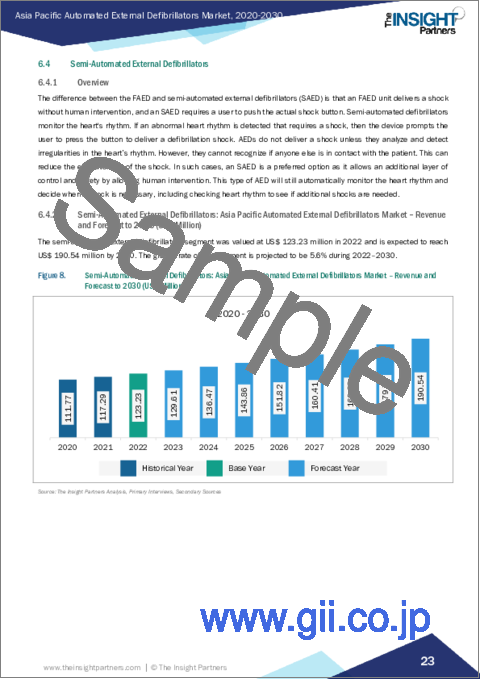|
|
市場調査レポート
商品コード
1494559
アジア太平洋の自動体外式除細動器:2030年市場予測-地域別分析-タイプ別、エンドユーザー別Asia Pacific Automated External Defibrillators Market Forecast to 2030 - Regional Analysis - by Type (Fully-Automated External Defibrillators and Semi- Automated External Defibrillators) and End User (Hospitals & Clinics, Homecare, and Others) |
||||||
|
|||||||
| アジア太平洋の自動体外式除細動器:2030年市場予測-地域別分析-タイプ別、エンドユーザー別 |
|
出版日: 2024年04月05日
発行: The Insight Partners
ページ情報: 英文 79 Pages
納期: 即納可能
|
全表示
- 概要
- 図表
- 目次
アジア太平洋の自動体外式除細動器市場は、2022年の2億8,742万米ドルから2030年には4億3,107万米ドルに成長すると予測されています。2022~2030年のCAGRは5.2%を記録すると推定されます。
新興市場でのプレゼンスを拡大する主要市場参入企業の戦略がアジア太平洋自動体外式除細動器市場を牽引
アジア太平洋や中南米などの地域で心血管疾患の症例が増加していることから、自動体外式除細動器市場の参入企業はこれらの地域での成長を戦略化し始めているか、またはその見込みです。CVDは、インド、中国、ブラジルなどの国々で主要な死因の一つとなっています。Abbott、Medtronic、Asahi Kasei(ZOLL)、ビオトロニックなどの企業は、今後数年間、合併、買収、戦略的提携を通じて、これらの新興市場で成長を続けると予想されます。2020年4月、MedtroniはインドのハイデラバードにあるMedtronic Engineering and Innovation Center(MEIC)に投資し、再出発しました。同社は2011年に開設したMEICを拡大するために1億6,000万米ドルを投資しました。
ここ数年、Nihon Kohden、Medtronic、Asahi Kasei (ZOLL)などの企業がラテンアメリカやアジア太平洋に販売子会社を設立する動きが活発化しています。シンガポールに製造工場を持つBiotronikは、さらなる事業力強化のため、同国での研究開発を計画しています。さらに、除細動器とその使用法に関する認識とトレーニングの増加に伴い、公共の場に設置される自動体外式除細動器の数は今後数年間で増加すると予想されます。また、植込み型除細動器の需要は、国民医療費の増加、医療へのアクセスの増加、経済性の向上とともに、心血管疾患の治療のために医療サービスプロバイダーに接触する患者数の増加により拡大すると予想されます。例えば、東京に本社を置く医療機器メーカーであるNihon Kohdenは、2021年の3ヵ年事業計画において、アジア、北米、南米における蘇生用製品の顧客基盤の拡大を目指すと発表しました。この目標は、手頃な価格の除細動器モデルを開発し、AEDの利用率を向上させるソリューションを提供することで達成できます。このように、新興市場でのプレゼンスを拡大しようとする主要市場参入企業の成長戦略は、今後数年間、自動体外式除細動器市場の成長に有利な機会を生み出す可能性が高いです。
アジア太平洋の自動体外式除細動器市場概要
アジア太平洋の自動体外式除細動器市場は、さらに中国、日本、インド、韓国、オーストラリア、その他のアジア太平洋に区分されます。同地域の市場成長は、慢性疾患の罹患率の上昇、製品発売数の増加、製品開発への投資の増加、高齢化人口の急増などの要因によって決定されます。アジア太平洋では、中国が数量ベースで最大の市場です。同市場の成長は主に、中国における心房細動(AF)の有病率の増加、その他のさまざまな心臓病による負担の増加、同国全体における高齢者人口の増加に起因しています。世界心臓連盟の推定によると、虚血性心疾患や脳卒中などの心血管イベントは、2010~2030年の間に中国の人口の間で50%増加すると予想されています。心血管疾患は、タバコの喫煙、アルコール摂取、その他の座りがちな生活習慣の増加の結果です。高血圧と肥満もまた、座りがちな生活習慣がもたらす致命的な結果です。例えば、2020年の国勢調査データによると、中国では約2億6,400万人が60歳以上の年齢層であり、人口のほぼ19%を占めています。これらの人々は、病歴または心電図スクリーニングのいずれかに基づいて心房細動と診断されました。中国の人口の中で、冠動脈性心疾患(CHD)は心血管系の死因の第2位であり、都市部では心血管系の死因の22%、農村部では13%を占めています。しかし、中国のCHDによる死亡率は欧米諸国と比較して比較的低いです。CHDの負担は増加の一途をたどっています。米国生物工学情報センター(NCBI)によると、CVDの発症率は継続的に増加し、この増加傾向は今後10年間続くという予測がなされています。中国国家高齢化委員会(CNCA)は、2050年までに高齢者人口全体が4億8,700万人に達すると推定しています。このような高齢者人口の急激な増加や、継続的なモニタリングを必要とする心血管系の症例は、市場の成長に寄与すると予想されます。
さらに、中国の医療機器市場は、健康上の問題を容易に検出するためのハイテク医療機器の輸入需要の増加によって支えられています。中国の病院や医療プロバイダー、中国政府は、医療の質の向上に注力しています。これらの要因は、今後数年間、同国における自動体外式除細動器の需要を促進する可能性が高いです。
アジア太平洋の自動体外式除細動器市場の収益と2030年までの予測(金額)
アジア太平洋の自動体外式除細動器市場セグメンテーション
アジア太平洋の自動体外式除細動器市場は、タイプ、エンドユーザー、国に区分されます。
タイプ別に見ると、アジア太平洋の自動体外式除細動器市場は全自動体外式除細動器と半自動体外式除細動器に二分されます。2022年のアジア太平洋の自動体外式除細動器市場では、全自動体外式除細動器セグメントが大きなシェアを占めています。
エンドユーザー別に見ると、アジア太平洋の自動体外式除細動器市場は病院とクリニック、在宅医療、その他に区分されます。2022年のアジア太平洋自動体外式除細動器市場では、病院とクリニックセグメントが最大のシェアを占めています。
国別では、アジア太平洋自動体外式除細動器市場は、中国、日本、インド、韓国、オーストラリア、その他のアジア太平洋に区分されます。2022年のアジア太平洋自動体外式除細動器市場は中国が独占しています。
Asahi Kasei Corp、BPL Medical Technologies Pvt Ltd、CU Medical Systems Inc、Koninklijke Philips NV、Mediana Co Ltd、日本光電工業、Schiller AG、Shenzhen Mindray Bio-Medical Electronics Co Ltd、Stryker Corpは、アジア太平洋の自動体外式除細動器市場で事業を展開している大手企業です。
目次
第1章 イントロダクション
第2章 エグゼクティブ概要
第3章 調査手法
- 対象範囲
- 2次調査
- 1次調査
第4章 アジア太平洋の自動体外式除細動器市場-主要産業力学
- 主要市場促進要因
- 心血管疾患の有病率の増加
- 自動体外式除細動器に関する教育・啓発プログラムの増加
- 市場抑制要因
- 自動体外式除細動器に関する性能問題
- 市場機会
- 新興市場でのプレゼンスを拡大するための主要市場参入企業の戦略
- 今後の動向
- 技術の進歩
- 影響分析
第5章 自動体外式除細動器市場:アジア太平洋市場分析
- アジア太平洋の自動体外式除細動器市場収益(2020~2030年)
第6章 アジア太平洋自動体外式除細動器市場:タイプ別収益と2030年までの予測
- イントロダクション
- アジア太平洋の自動体外式除細動器市場:2022年と2030年のタイプ別売上高シェア(%)
- 全自動体外式除細動器
- 半自動体外式除細動器
第7章 アジア太平洋自動体外式除細動器市場:エンドユーザー別収益と2030年までの予測
- イントロダクション
- アジア太平洋の自動体外式除細動器市場:2022年と2030年のエンドユーザー別売上高シェア(%)
- 病院とクリニック
- 在宅医療
- その他
第8章 アジア太平洋の自動体外式除細動器市場:国別分析
- アジア太平洋
- 中国
- 日本
- インド
- オーストラリア
- 韓国
- その他のアジア太平洋
第9章 自動体外式除細動器市場-業界情勢
- イントロダクション
- 有機的成長戦略
- 無機的成長戦略
第10章 企業プロファイル
- Shenzhen Mindray Bio-Medical Electronics Co Ltd
- Stryker Corp
- BPL Medical Technologies Pvt Ltd
- Schiller AG
- Mediana Co Ltd
- Nihon Kohden Corp
- Asahi Kasei Corp
- CU Medical Systems Inc
- Koninklijke Philips NV
第11章 付録
List Of Tables
- Table 1. Asia Pacific Automated External Defibrillators Market Segmentation
- Table 2. China: Automated External Defibrillator Market Revenue and Forecast to 2030 (CHINA$ Mn) - Type
- Table 3. China: Automated External Defibrillator Market Revenue and Forecast to 2030 (GERMANY$ Mn) - End User
- Table 4. Japan: Automated External Defibrillator Market Revenue and Forecast to 2030 (US$ Mn) - Type
- Table 5. Japan: Automated External Defibrillator Market Revenue and Forecast to 2030 (US$ Mn) - End User
- Table 6. India: Automated External Defibrillator Market Revenue and Forecast to 2030 (US$ Mn) - Type
- Table 7. India: Automated External Defibrillator Market Revenue and Forecast to 2030 (US$ Mn) - End User
- Table 8. Australia: Automated External Defibrillator Market Revenue and Forecast to 2030 (AUSTRALIA$ Mn) - Type
- Table 9. Australia: Automated External Defibrillator Market Revenue and Forecast to 2030 (US$ Mn) - End User
- Table 10. South Korea: Automated External Defibrillator Market Revenue and Forecast to 2030 (US$ Mn) - Type
- Table 11. South Korea: Automated External Defibrillator Market Revenue and Forecast to 2030 (US$ Mn) - End User
- Table 12. Rest of Asia Pacific: Automated External Defibrillator Market Revenue and Forecast to 2030 (US$ Mn) - Type
- Table 13. Rest of Asia Pacific: Automated External Defibrillator Market Revenue and Forecast to 2030 (US$ Mn) - End User
- Table 14. Recent Organic Growth Strategies in Automated External Defibrillators Market
- Table 15. Recent Inorganic Growth Strategies in the Automated External Defibrillators Market
- Table 16. Glossary of Terms, Asia Pacific Automated External Defibrillators Market
List Of Figures
- Figure 1. Asia Pacific Automated External Defibrillators Market Segmentation, By Country
- Figure 2. Key Insights
- Figure 3. Asia Pacific Automated External Defibrillators Market - Key Industry Dynamics
- Figure 4. Impact Analysis of Drivers and Restraints
- Figure 5. Asia Pacific Automated External Defibrillators Market Revenue (US$ Mn), 2020 - 2030
- Figure 6. Asia Pacific Automated External Defibrillators Market Revenue Share, by Type 2022 & 2030 (%)
- Figure 7. Fully-Automated External Defibrillators: Asia Pacific Automated External Defibrillators Market - Revenue and Forecast to 2030 (US$ Million)
- Figure 8. Semi-Automated External Defibrillators: Asia Pacific Automated External Defibrillators Market - Revenue and Forecast to 2030 (US$ Million)
- Figure 9. Asia Pacific Automated External Defibrillators Market Revenue Share, by End User 2022 & 2030 (%)
- Figure 10. Hospitals and Clinics: Asia Pacific Automated External Defibrillators Market - Revenue and Forecast to 2030 (US$ Million)
- Figure 11. Home Care Settings: Asia Pacific Automated External Defibrillators Market - Revenue and Forecast to 2030 (US$ Million)
- Figure 12. Others: Asia Pacific Automated External Defibrillators Market - Revenue and Forecast to 2030 (US$ Million)
- Figure 13. Asia Pacific Automated External Defibrillator Market, By Key Country - Revenue (2022) (US$ Million)
- Figure 14. Asia Pacific: Automated External Defibrillator Market, By Countries, 2022 And 2030 (%)
- Figure 15. China: Automated External Defibrillator Market Revenue and Forecast to 2030 (CHINA$ Mn)
- Figure 16. Japan: Automated External Defibrillator Market Revenue and Forecast to 2030 (US$ Mn)
- Figure 17. India: Automated External Defibrillator Market Revenue and Forecast to 2030 (US$ Mn)
- Figure 18. Australia: Automated External Defibrillator Market Revenue and Forecast to 2030 (AUSTRALIA$ Mn)
- Figure 19. South Korea: Automated External Defibrillator Market Revenue and Forecast to 2030 (US$ Mn)
- Figure 20. Rest of Asia Pacific: Automated External Defibrillator Market Revenue and Forecast to 2030 (US$ Mn)
The Asia Pacific automated external defibrillators market is expected to grow from US$ 287.42 million in 2022 to US$ 431.07 million by 2030. It is estimated to record a CAGR of 5.2% from 2022 to 2030.
Strategies by Key Market Players to Expand Presence in Emerging Markets Drive Asia Pacific Automated External Defibrillators Market
With rising cases of cardiovascular diseases in regions such as Asia Pacific and South & Central America, the automated external defibrillator market players have started to or are expected to strategize their growth in these regions. CVDs have been among the leading causes of death in countries such as India, China, and Brazil. Companies such as Abbott, Medtronic, Asahi Kasei (ZOLL), and Biotronik are expected to continue growing in these emerging markets through mergers, acquisitions, and strategic partnerships in the coming years. In April 2020, Medtronic invested and relaunched the Medtronic Engineering and Innovation Center (MEIC) in Hyderabad, India. The company has invested US$ 160 million to expand the MEIC, which initially opened in 2011.
Over the years, there has been a rise in the establishment of sales subsidiaries in Latin America and Asia Pacific by companies such as Nihon Kohden, Medtronic, and Asahi Kasei (ZOLL). Biotronik, with its already established manufacturing plant in Singapore, is planning on implementing its research and development activities in the country to further strengthen its business capabilities. In addition, the number of public-access automated external defibrillator setups is expected to rise in the coming years, with increasing awareness and training regarding defibrillators and their usage. Also, the demand for implantable defibrillators is expected to grow owing to the rising number of patients approaching healthcare service providers for the treatment of cardiovascular diseases, along with elevating national healthcare expenditures, increasing access to care, and improving economics. For instance, Nihon Kohden, a Tokyo-based medical equipment manufacturer, announced in its 2021 three-year business plan that the company aims to expand its customer base for resuscitation products in Asia, North America, and South America. This aim can be achieved by developing affordable models of defibrillators and providing solutions for improving the utilization rates of AEDs. Thus, growing strategies by key market players to expand their presence in emerging markets are likely to create lucrative opportunities for the automated external defibrillator market growth in the coming years.
Asia Pacific Automated External Defibrillators Market Overview
The automated external defibrillator market in Asia Pacific is further segmented into China, Japan, India, South Korea, Australia, and the Rest of Asia Pacific. The market growth in the region is determined by factors such as the rising incidences of chronic diseases, increasing number of product launches, growing investments for product developments, and a surge in the aging population. In Asia Pacific, China is the largest market by volume. The growth of the market is mainly attributed to the increasing prevalence of atrial fibrillation (AF) in China, the increasing burden of various other heart diseases, and the rising geriatric population across the country. As per the estimation of the World Heart Federation, cardiovascular events such as ischemic heart disease and stroke are expected to rise by 50% among the Chinese population between 2010 and 2030. Cardiovascular diseases are a result of increased tobacco smoking, alcohol consumption, and other sedentary lifestyle habits. Hypertension and obesity are again fatal outcomes of sedentary lifestyle. For instance, according to the 2020 census data, in China, ~264 million people were in the age group of 60 and over and accounted for almost 19% of the population. These populations were diagnosed with AF based on either a medical history or ECG screening. Among the Chinese population, coronary heart disease (CHD) is the second leading cause of cardiovascular death, accounting for 22% of cardiovascular deaths in urban areas and 13% in rural areas. However, mortality from CHD in China is relatively low compared to Western countries. The burden of CHD has been increasing. According to the National Center for Biotechnology Information (NCBI), projections have been made that CVD incidence will be growing continuously, and this upward trend will continue till the next decade. The China National Committee on Aging (CNCA) estimated that the overall geriatric population is expected to reach 487 million by 2050. Such rapid rise in the elderly population and cardiovascular cases requiring continuous monitoring is anticipated to contribute to the market's growth.
Moreover, the medical device market in China is buoyed by the increase in the demand for high-tech medical device imports to detect health problems easily. Chinese hospitals and healthcare providers and the Chinese government are focused on improving the quality of care. These factors are likely to propel the demand for automated external defibrillators in the country in the coming years.
Asia Pacific Automated External Defibrillators Market Revenue and Forecast to 2030 (US$ Million)
Asia Pacific Automated External Defibrillators Market Segmentation
The Asia Pacific automated external defibrillators market is segmented into type, end user, and country.
Based on type, the Asia Pacific automated external defibrillators market is bifurcated into fully-automated external defibrillators and semi- automated external defibrillators. The fully-automated external defibrillators segment held a larger share of the Asia Pacific automated external defibrillators market in 2022.
Based on end user, the Asia Pacific automated external defibrillators market is segmented into hospitals & clinics, homecare, and others. The hospitals & clinics segment held the largest share of the Asia Pacific automated external defibrillators market in 2022.
Based on country, the Asia Pacific automated external defibrillators market is segmented into China, Japan, India, South Korea, Australia, and the Rest of Asia Pacific. China dominated the Asia Pacific automated external defibrillators market in 2022.
Asahi Kasei Corp, BPL Medical Technologies Pvt Ltd, CU Medical Systems Inc, Koninklijke Philips NV, Mediana Co Ltd, Nihon Kohden Corp, Schiller AG, Shenzhen Mindray Bio-Medical Electronics Co Ltd, and Stryker Corp are some of the leading companies operating in the Asia Pacific automated external defibrillators market.
Table Of Contents
1. Introduction
- 1.1 The Insight Partners Research Report Guidance
- 1.2 Market Segmentation
2. Executive Summary
3. Research Methodology
- 3.1 Coverage
- 3.2 Secondary Research
- 3.3 Primary Research
4. Asia Pacific Automated External Defibrillators Market - Key Industry Dynamics
- 4.1 Key Market Drivers:
- 4.1.1 Increasing Prevalence of Cardiovascular Diseases
- 4.1.2 Rising Training and Awareness Programs on Automated External Defibrillators
- 4.2 Market Restraints
- 4.2.1 Performance Issues Related to Automated External Defibrillators
- 4.3 Market Opportunities
- 4.3.1 Strategies by Key Market Players to Expand Presence in Emerging Markets
- 4.4 Future Trends
- 4.4.1 Technological Advancements
- 4.5 Impact Analysis:
5. Automated External Defibrillators Market - Asia Pacific Market Analysis
- 5.1 Asia Pacific Automated External Defibrillators Market Revenue (US$ Mn), 2020 - 2030
6. Asia Pacific Automated External Defibrillators Market - Revenue and Forecast to 2030 - by Type
- 6.1 Overview
- 6.2 Asia Pacific Automated External Defibrillators Market Revenue Share, by Type 2022 & 2030 (%)
- 6.3 Fully-Automated External Defibrillators
- 6.3.1 Overview
- 6.3.2 Fully-Automated External Defibrillators: Asia Pacific Automated External Defibrillators Market - Revenue and Forecast to 2030 (US$ Million)
- 6.4 Semi-Automated External Defibrillators
- 6.4.1 Overview
- 6.4.2 Semi-Automated External Defibrillators: Asia Pacific Automated External Defibrillators Market - Revenue and Forecast to 2030 (US$ Million)
7. Asia Pacific Automated External Defibrillators Market - Revenue and Forecast to 2030 - by End User
- 7.1 Overview
- 7.2 Asia Pacific Automated External Defibrillators Market Revenue Share, by End User 2022 & 2030 (%)
- 7.3 Hospitals and Clinics
- 7.3.1 Overview
- 7.3.2 Hospitals and Clinics: Asia Pacific Automated External Defibrillators Market - Revenue and Forecast to 2030 (US$ Million)
- 7.4 Home Care Settings
- 7.4.1 Overview
- 7.4.2 Home Care Settings: Asia Pacific Automated External Defibrillators Market - Revenue and Forecast to 2030 (US$ Million)
- 7.5 Others
- 7.5.1 Overview
- 7.5.2 Others: Asia Pacific Automated External Defibrillators Market - Revenue and Forecast to 2030 (US$ Million)
8. Asia Pacific Automated External Defibrillators Market - Country Analysis
- 8.1 Asia Pacific
- 8.1.1 Asia Pacific: Automated External Defibrillator Market, by Country
- 8.1.1.1 China
- 8.1.1.1.1 Overview
- 8.1.1.1.2 China: Automated External Defibrillator Market Revenue and Forecast to 2030 (CHINA$ Mn)
- 8.1.1.1.3 China: Automated External Defibrillator Market, by Type
- 8.1.1.1.4 China: Automated External Defibrillator Market, by End User
- 8.1.1.2 Japan
- 8.1.1.2.1 Overview
- 8.1.1.2.2 Japan: Automated External Defibrillator Market Revenue and Forecast to 2030 (US$ Mn)
- 8.1.1.2.3 Japan: Automated External Defibrillator Market, by Type
- 8.1.1.2.4 Japan: Automated External Defibrillator Market, by End User
- 8.1.1.3 India
- 8.1.1.3.1 Overview
- 8.1.1.3.2 India: Automated External Defibrillator Market Revenue and Forecast to 2030 (US$ Mn)
- 8.1.1.3.3 India: Automated External Defibrillator Market, by Type
- 8.1.1.3.4 India: Automated External Defibrillator Market, by End User
- 8.1.1.4 Australia
- 8.1.1.4.1 Overview
- 8.1.1.4.2 Australia: Automated External Defibrillator Market Revenue and Forecast to 2030 (AUSTRALIA$ Mn)
- 8.1.1.4.3 Australia: Automated External Defibrillator Market, by Type
- 8.1.1.4.4 Australia: Automated External Defibrillator Market, by End User
- 8.1.1.5 South Korea
- 8.1.1.5.1 Overview
- 8.1.1.5.2 South Korea: Automated External Defibrillator Market Revenue and Forecast to 2030 (US$ Mn)
- 8.1.1.5.3 South Korea: Automated External Defibrillator Market, by Type
- 8.1.1.5.4 South Korea: Automated External Defibrillator Market, by End User
- 8.1.1.6 Rest of Asia Pacific
- 8.1.1.6.1 Overview
- 8.1.1.6.2 Rest of Asia Pacific: Automated External Defibrillator Market Revenue and Forecast to 2030 (US$ Mn)
- 8.1.1.6.3 Rest of Asia Pacific: Automated External Defibrillator Market, by Type
- 8.1.1.6.4 Rest of Asia Pacific: Automated External Defibrillator Market, by End User
- 8.1.1.1 China
- 8.1.1 Asia Pacific: Automated External Defibrillator Market, by Country
9. Automated External Defibrillators Market-Industry Landscape
- 9.1 Overview
- 9.2 Organic Growth Strategies
- 9.2.1 Overview
- 9.3 Inorganic Growth Strategies
- 9.3.1 Overview
10. Company Profiles
- 10.1 Shenzhen Mindray Bio-Medical Electronics Co Ltd
- 10.1.1 Key Facts
- 10.1.2 Business Description
- 10.1.3 Products and Services
- 10.1.4 Financial Overview
- 10.1.5 SWOT Analysis
- 10.1.6 Key Developments
- 10.2 Stryker Corp
- 10.2.1 Key Facts
- 10.2.2 Business Description
- 10.2.3 Products and Services
- 10.2.4 Financial Overview
- 10.2.5 SWOT Analysis
- 10.2.6 Key Developments
- 10.3 BPL Medical Technologies Pvt Ltd
- 10.3.1 Key Facts
- 10.3.2 Business Description
- 10.3.3 Products and Services
- 10.3.4 Financial Overview
- 10.3.5 SWOT Analysis
- 10.3.6 Key Developments
- 10.4 Schiller AG
- 10.4.1 Key Facts
- 10.4.2 Business Description
- 10.4.3 Products and Services
- 10.4.4 Financial Overview
- 10.4.5 SWOT Analysis
- 10.4.6 Key Developments
- 10.5 Mediana Co Ltd
- 10.5.1 Key Facts
- 10.5.2 Business Description
- 10.5.3 Products and Services
- 10.5.4 Financial Overview
- 10.5.5 SWOT Analysis
- 10.5.6 Key Developments
- 10.6 Nihon Kohden Corp
- 10.6.1 Key Facts
- 10.6.2 Business Description
- 10.6.3 Products and Services
- 10.6.4 Financial Overview
- 10.6.5 SWOT Analysis
- 10.6.6 Key Developments
- 10.7 Asahi Kasei Corp
- 10.7.1 Key Facts
- 10.7.2 Business Description
- 10.7.3 Products and Services
- 10.7.4 Financial Overview
- 10.7.5 SWOT Analysis
- 10.7.6 Key Developments
- 10.8 CU Medical Systems Inc
- 10.8.1 Key Facts
- 10.8.2 Business Description
- 10.8.3 Products and Services
- 10.8.4 Financial Overview
- 10.8.5 SWOT Analysis
- 10.8.6 Key Developments
- 10.9 Koninklijke Philips NV
- 10.9.1 Key Facts
- 10.9.2 Business Description
- 10.9.3 Products and Services
- 10.9.4 Financial Overview
- 10.9.5 SWOT Analysis
- 10.9.6 Key Developments
11. Appendix
- 11.1 About Us
- 11.2 Glossary of Terms






